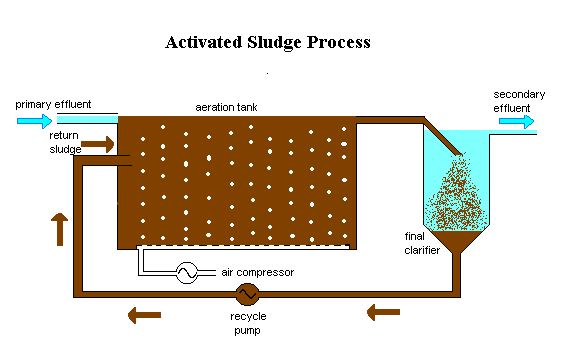Secondary treatment uses
biological treatment processes. Microorganisms convert
nonsettleable solids into settleable solids. Sedimentation typically
follows, allowing the settleable solids to settle out. It removes
approximately 85% of the BOD and TSS in wastewater. Secondary
treatment for municipal wastewater is the minimum level of treatment
required by the Clean Water Act. It includes:
1. Activated Sludge- This is the most common
option in secondary treatment. It starts with aeration that
encourages the growth of microbes in the waste. The microbes feed on
the organic material, which then allows solids to settle out.
Bacteria-containing "activated sludge" is continually recirculated
back to the aeration basin to increase the rate of organic
decomposition.

A closer look reveals how air is release from the bottom of the
tank.

2. Trickling Filters- These are open tanks of "coarse
media" (rocks about 3 inches in diameter -- usually stones or
plastic, and not sand!) about 3-10 ft. deep. Wastewater
is sprayed into the air (aeration), then allowed to trickle through
the coarse media. Despite its name, trickling filters do not actually
filter the water. Instead, the larger stones serve as a surface on
which microbes grow. These microbes, attached to and growing on the
stones, break down organic material in the wastewater. Trickling
filters drain at the bottom; the wastewater is collected and then
undergoes sedimentation.
3. Lagoons- (oxidation ponds or stabilization ponds): this
method uses ponds to treat wastewater. Algae grow within the lagoons
and utilize sunlight to produce oxygen, which is in turn used by
microorganisms in the lagoon to break down organic material in the
wastewater. Wastewater solids settle in the lagoon,
resulting in effluent that is relatively well treated, although it
does contain algae. These are slow, cheap, and relatively
inefficient, but can be used for various types of wastewater. They
rely on the interaction of sunlight, algae, microorganisms, and
oxygen (sometimes aerated).


After primary and secondary treatment, municipal
wastewater is usually disinfected using chlorine (or other
disinfecting compounds, or occasionally ozone or ultraviolet light).
An increasing number of wastewater facilities also employ tertiary
treatment, often using advanced treatment methods.
Tertiary treatment (sometimes called
"advanced treatment" ) includes any level of treatment beyond
secondary treatment. These processes can be physical, biological, or
chemical. Processes for treating drinking water can be adapted to
tertiary treatment. They can include: filtration, activated carbon
adsorption, and coagulation.



